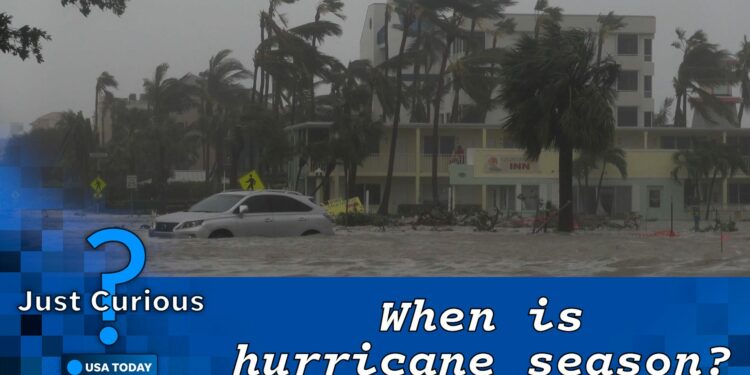When is hurricane season? Here’s when you can expect the most storms.
When do most hurricanes happen? Here’s what to know about the hurricane season and how you can prepare.
Hurricane Beryl, a fierce Category 3 storm that exploded in intensity over the weekend, was poised to make landfall early Monday on the Windward Islands.
Beryl is expected to remain an “extremely dangerous major hurricane” as its core moves through the Windward Islands into the eastern Caribbean, National Weather Service forecaster Eric Blake said in an advisory early Monday. Some weakening is expected in the central Caribbean by midweek, but Beryl is forecast to remain a hurricane.
“Potentially catastrophic wind damage is expected where the core of Beryl moves through portions of the Windward Islands,” Blake warned.
The historic Beryl reached tropical storm status Friday before becoming a major hurricane Sunday as it raced toward the Caribbean with winds of 130 mph − a gain of 95 mph in just 42.5 hours. Record-warm ocean temperatures led to rapid intensification, a phenomenon that occurs when a storm strengthens by at least 35 mph in a 24-hour period.
The storm became the earliest Category 4 hurricane on record and the first June major hurricane east of the Lesser Antilles on record. Beryl hit Category 4 status Sunday, but its winds decreased slightly overnight, making it a Category 3 storm Monday.
Beryl was 125 miles east-southeast of Grenada early Monday, moving toward the west at nearly 20 mph. The storm was driving maximum sustained winds near 120 mph with higher gusts, making it a Category 3 hurricane on the Saffir-Simpson Hurricane Wind Scale.
Developments:
∎ Storm surge in the Windward Islands could reach 6 to 9 feet above normal tide levels and bring “large, destructive waves” to the coast, the National Hurricane Center said.
∎ Rainfall could cause flooding and is expected to dump 3 to 6 inches in Barbados and the Windward Islands by Monday morning. Up to 10 inches are possible in isolated locations, especially in the Grenadines.
∎ After Beryl’s center moves across the Windward Islands on Monday, the storm will cross the southeastern and central Caribbean Sea late Monday through Wednesday.
How Beryl grew: Hurricane Beryl, super-charged by warm seas, stuns experts
The hurricane center expects Beryl to remain a hurricane as it reaches Mexico’s Yucatan Peninsula on Friday. AccuWeather hurricane experts expect the U.S. to avoid any major impact from the storm. Still, residents should not let their guard down.
“The most likely scenario is for the storm to move westward into Mexico,” AccuWeather Lead Hurricane Forecaster Alex DaSilva said. “However, it is very important to note that if the high pressure across the Southeast weakens, that can allow the storm to move farther north and potentially directly impact the Gulf Coast.”
Beryl on the move: Hurricane Beryl an ‘extremely dangerous’ Cat 4 storm as it roars toward Caribbean
Rapid intensification is a process in which a storm undergoes accelerated growth: The phenomenon is typically defined to be a tropical cyclone (whether a tropical storm or hurricane) intensifying by at least 35 mph in a 24-hour period.
“Rapid intensification occurs when a tropical storm or hurricane encounters an extremely conducive environment,” Colorado State University hurricane researcher Phil Klotzbach said. “Typically, this environment consists of very warm water, low vertical wind shear and high levels of midlevel moisture.”
The Windward Islands are the group of Caribbean islands in the eastern part of the Caribbean Sea. They include Dominica, St. Lucia, St. Vincent and the Grenadines and Grenada. Barbados and Trinidad and Tobago are sometimes included in the group.
They are called “windward” − which means upward from a given point − because they are more windward to arriving ships than the Leeward Islands.
Federal forecasters have predicted a hurricane season unlike any other, with as many as 25 named storms possible.
It is the most storms the National Oceanic and Atmospheric Administration has ever predicted in a preseason outlook. “All the ingredients are in place for an active season,” National Weather Service director Ken Graham said in May.
NOAA director Rick Spinrad said the Atlantic hurricane season is shaping up to be “extraordinary” − an 85% chance for an above-average year. “The forecast … is the highest NOAA has ever issued for the May outlook,” he said.
Contributing: Dinah Voyles Pulver, Doyle Rice, USA TODAY
Source link : https://www.usatoday.com/story/news/nation/2024/07/01/hurricane-beryl-landfall-live-news-updates/74261881007/
Author :
Publish date : 2024-07-01 07:02:05
Copyright for syndicated content belongs to the linked Source.





